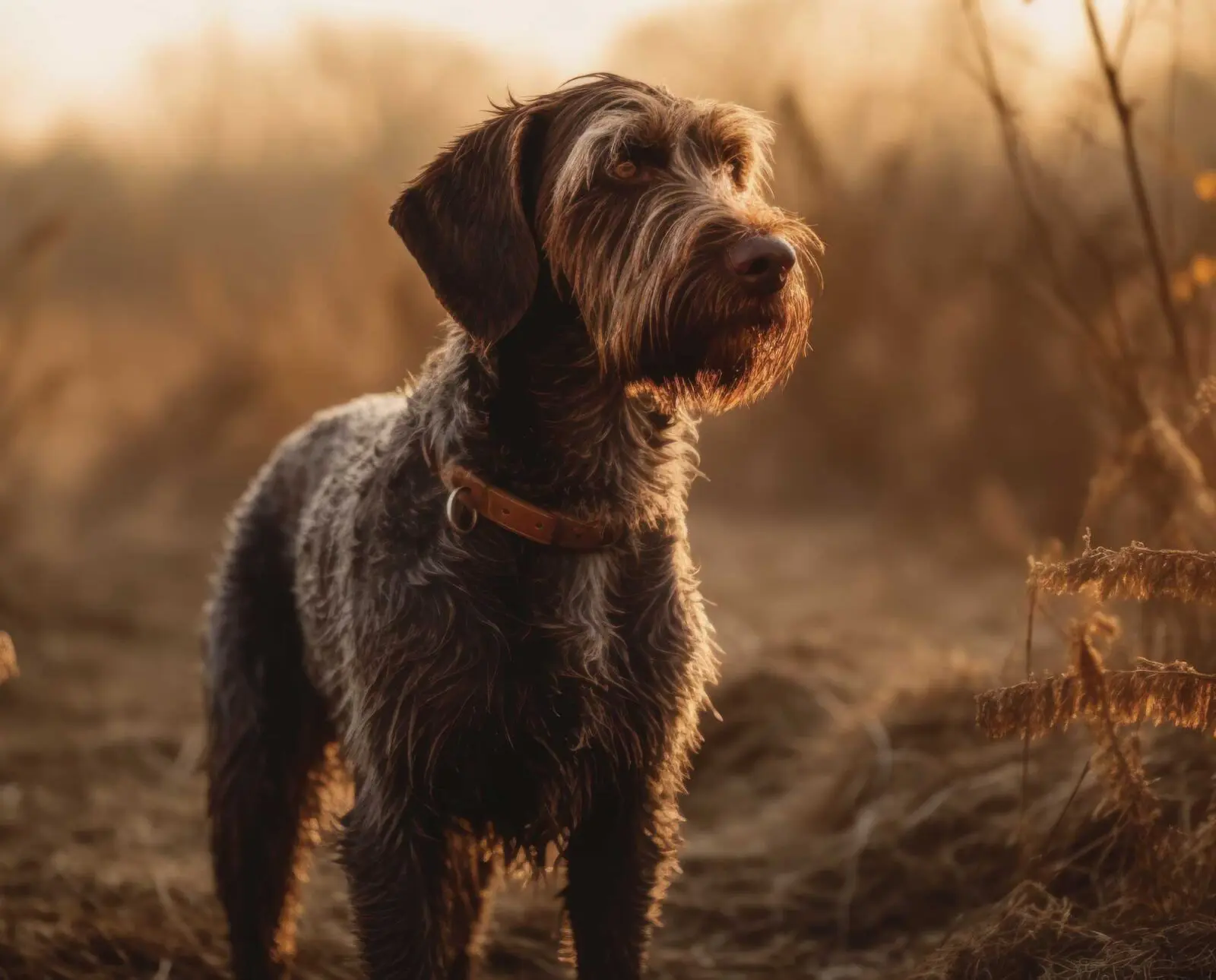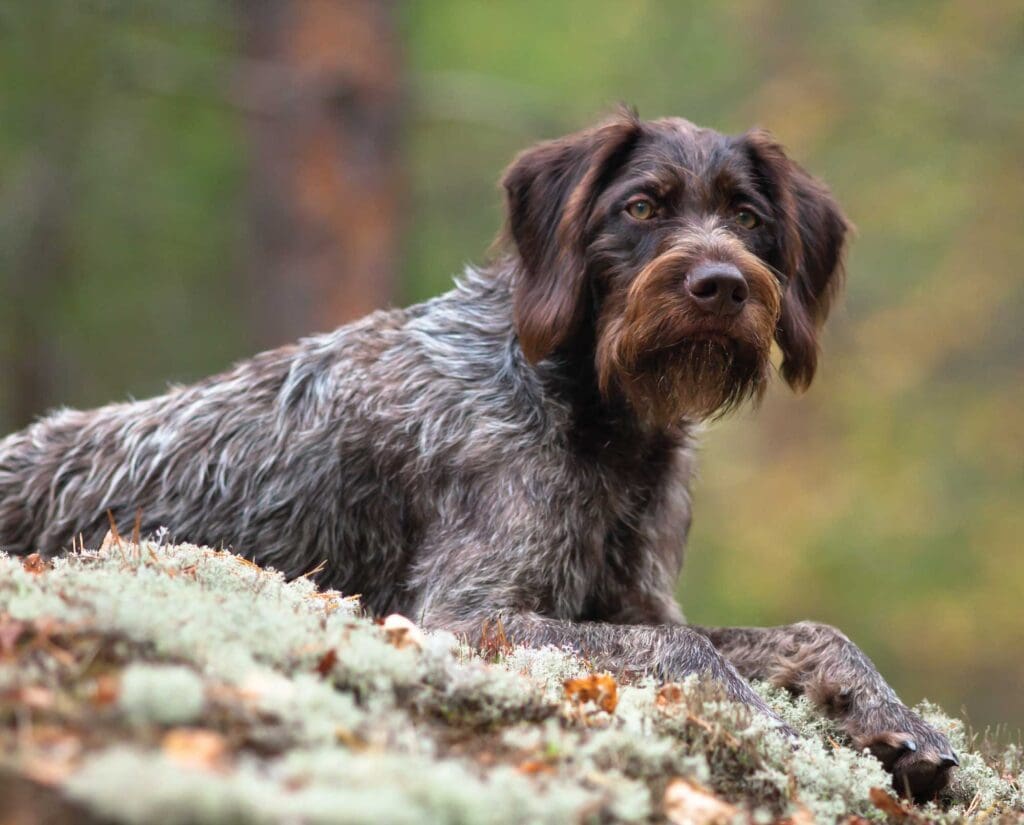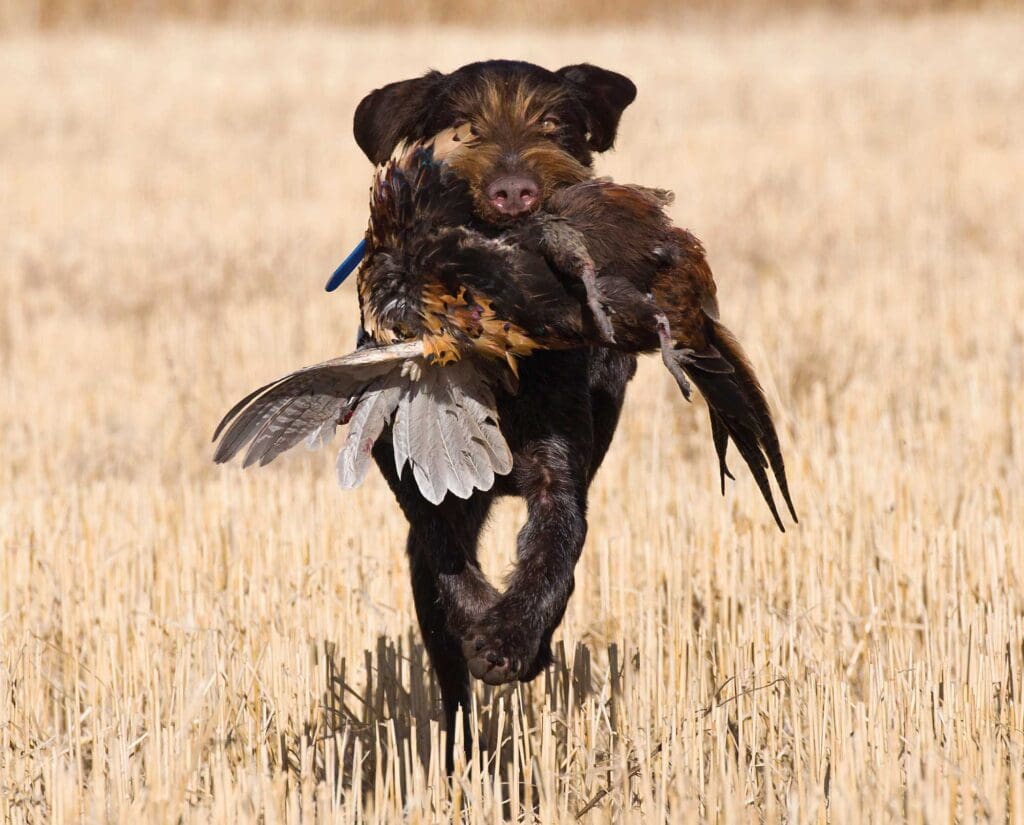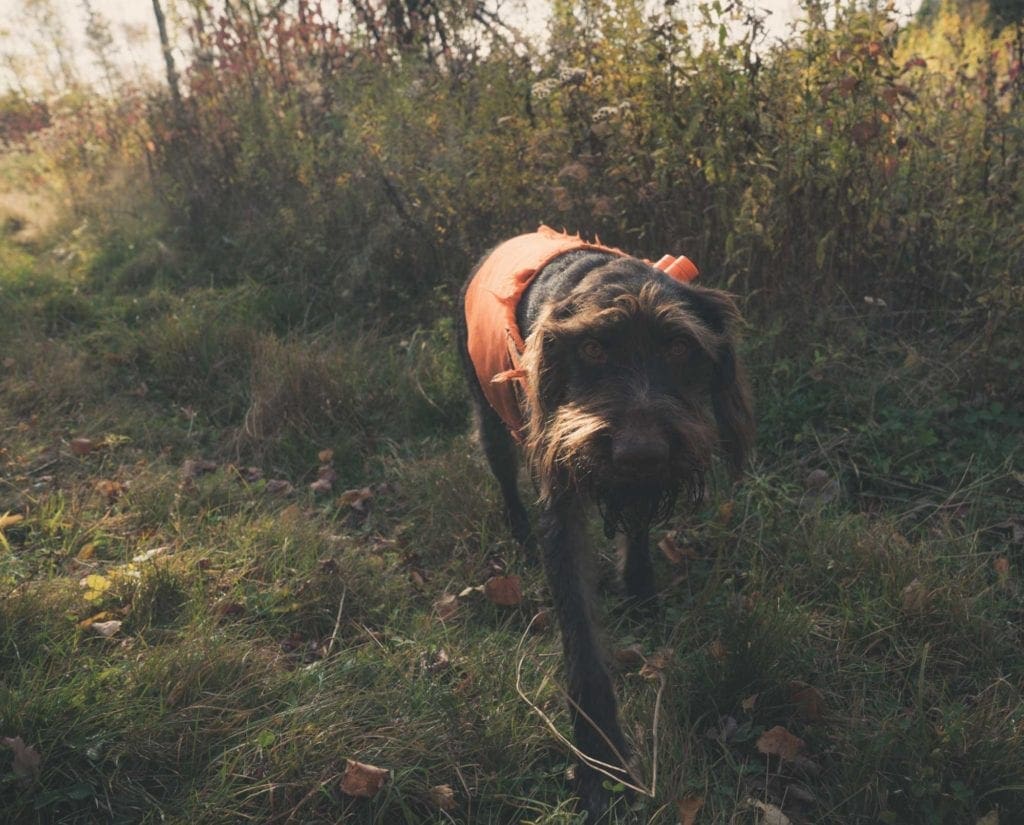Home » Hunting Dogs » German Wirehaired Pointer: Dog Breed Information, Form, Function, History, and More
German Wirehaired Pointer: Dog Breed Information, Form, Function, History, and More

Gabby Zaldumbide is Project Upland's Editor in Chief. Gabby was…
Built for both land and water, the German Wirehaired Pointer defines versatility
Wiry beards, grandpa-esque eyebrows, powerful instincts, and intelligent eyes are key features of the beloved German Wirehaired Pointer (GWP). A well-known pointing breed, the GWP ranks as the fifth most popular dog breed owned by bird hunters, according to Project Upland’s annual survey.
Nancy Anisfield, the creative director of Ugly Dog Hunting Company, said the original purpose of the German Wirehaired Pointer was to be a high-performance, versatile hunting dog. “This is unlike some pointing breeds who were initially developed for just one type of hunting or terrain,” she said. “Wirehair breeders first used stichelhaars and pudelpointers, only to add in griffons and shorthairs later. They were selecting attributes that would create a dog adept at serving waterfowlers and on-foot upland hunters. At the same time, they sought a low-maintenance coat that could withstand thick brush and cold water.”
Craig Koshyk, the author of Pointing Dogs Volume One: The Continentals and Pointing Dogs Volume Two: The British and Irish Breeds, deep-dives into GWP history, breeding, form, and function in his first volume. If you’ve got a copy of the book at home, check out pages 257 through 268. This article references his work quite a bit.
It’s important to note that German Wirehaired Pointers and Deutsch Drahthaars have much in common. However, the two breeds are separated by their breeding and performance requirements. Our Director of Operations, Jennifer Wapenski, explains this further in her article, “The Difference Between a Deutsch-Drahthaar and a German Wirehaired Pointer.”
German Wirehaired Pointer Form and Function
| Characteristic | Details |
| Size | MediumMales: 61-68 cmFemales: 57-64 cm |
| Tail | Docked to ⅖ length |
| Outer Coat | Harsh, flat-lying, 2-4 cm long |
| Undercoat | Dense, water-resistant |
| Furnishings | Mustache, beard, and eyebrows. Shorter on GWPs than on Griffons or Spinones. |
| Coat Color | Brown roan (70%), with or without brown patches. Brown roans may also have a white chest patch (10%). Solid brown coats (1%) can occur. Coat may also be black roan (20%) or solid black. |
| Amount of coat and size variation | High |
| Maturity | Early point, natural water drive, eager to please |
| Health | Sturdy and long-lived. Watch for von Willebrand’s disease, osteochondritis dissecans, osteochondrosis, hypothyroidism, and epilepsy. |
| Character | Varies widely. Generally intense and strong-willed but well-balanced hunters. May show a protection instinct as well. |
| Other Notable Features | Hunts everything from “snipe to moose.” Not great with cats. May be sensitive to heat. |
German Wirehaired Pointers are known for their energy, drive, and loyalty. In field searches, “they typically display an energetic, close to medium range field search,” writes Koshyk. Most of them are known to hunt at a medium gallop, which is slower than your average German Shorthaired Pointer but faster than some other German pointing breeds.
Regarding pointing, GWPs have a good reputation for a powerful pointing instinct that can show itself at a very young age. You can expect a GWP to have a classic, Continental point: the head and tail are level with the back when on point. However, American GWPs may show a high head and a nearly vertical tail.
German Wirehaired Pointers are considered the best of the best when it comes to retrieving. “The instinct to retrieve is seen early in most GWP pups and only needs to be channeled by the trainer to turn out a first-rate retriever,” writes Koshyk. “Hard mouth has been reported in some lines but is not considered widespread.”
German-bred GWPs generally have a strong emphasis on breeding for tracking abilities. Additionally, some German breeders select dogs that “give voice on trail.” However, breeders outside the German system tend not to breed for incredible tracking abilities. “Nevertheless, no matter what system is used to select the dogs, it would probably be difficult to find a GWP that is not a good tracker,” says Koshyk.
Koshyk continues, stating that GWPs are arguably the best choice for waterfowlers. Although they’re no Labrador or Chesapeake Bay Retriever, GWPs show an “intense retrieving instinct, strong prey drive and protective coat enable it to work on the toughest wetlands.”

History of the German Wirehaired Pointer
“The creators of the German Wirehaired Pointer…believed that all rough-haired pointing breeds were members of the same family and that breeding among them should be allowed,” writes Koshyk in Pointing Dogs Volume One. Instead of breeding dogs based on their appearance, GWP breeders selected for their hunting abilities. This, combined with forming a strict testing program, served as the foundation for the GWP as a breed.
These function-focused breeding activities took place around the turn of the 20th century. By 1904, Germany’s Wirehaired Club (Verein Drahthaar) had renamed itself the German Wirehaired Club (Verein Deutsch Drahthaar, VDD). This was a hallmark moment for the wire-haired breed since Germany already had long and short-haired pointing breeds.
Around World War I, the VDD had just a dozen members. However, by 1921, the club had over 1,000 members. By 1926, “German Wirehaired Pointers had become so popular that they made up nearly half of all dogs in the German versatile dog registry,” writes Koshyk. By the 1930s, it was Germany’s national dog.
Sadly, by the end of World War II, GWPs as a breed suffered due to decreased stock and even inadequate amounts of dog food. According to Wilhelm Heinrich, a GWP enthusiast, GWP breeders at the time “used almost everything that had a tail” to save the breed. “Breeders after WWII were also faced with a difficult problem,” he said. “They were allowed to breed dogs, but they were not allowed to have guns.” Although breeders in Western Germany could own guns again just a few years after they were outlawed, that was not the case in Eastern Germany. This delineated Eastern Germany dogs from Western Germany dogs in the post-war era; Eastern dogs were not used to the sound of gunfire, while Western dogs were. The Eastern and Western VDD clubs were not reunited until 1992.
“Today it is clear that the goals of the breed’s founders have been achieved and their approach to breeding, so hotly contested in the early years, completely validated,” writes Koshyk in Volume One. “The GWP is among the most successful pointing breeds on the planet. Few can rival its versatility, none come close to its popularity in Germany, and it is gaining supporters around the world every year.”

German Wirehaired Pointer Selection, Breeding, and Testing
As Anisfield mentioned, Pudelpointers, Stichelhaars, Griffons, and German Shorthaired Pointers were used to develop the GWP. It’s also theorized that Polish Waterdogs were one of the original breeds used to create the GWP. However, Koshyk notes that the term “Polish Waterdog” could also mean “Russian Setter” or “Icelandic Poodle” because those three terms were used to describe “pretty much any hunting dog with a rough coat, no matter where it came from.”
When the breed was developed in the early 1900s, breeders attempted to classify GWPs into five different types. These types included Witboi (Witboi vom Ruedenhof, 1896), Lump (Lump von Berge, 1899), Regent (Regent Auenheim, 1923), Odin (Odin vom Saarforst, 1925), and Harras (Harras Bigge, 1924). However, “the idea of the five types is historically very interesting, but nobody would try to find these types in modern GWPs,” according to Wilhelm Heinrich.
German Wirehaired Pointers were developed around the same time as the versatile dog testing system was established in Germany. Both are widely popular in the country and across the world today. Over 3,000 pups are born in Germany yearly, and over 1,000 are born in other European countries. The United States and Canada have a robust breed presence, and almost 500 GWP pups are born in North America each year to qualified parents. Participating in the NAVHDA testing system is also popular for GWP breeders in North America.

In the opening paragraphs of his chapter on German Wirehaired Pointers, Koshyk succinctly summed up the breed when praising his close friend’s female GWP:
“Despite having spent over 14 hours in a crate, the minute that pup was let out she jumped into her new owner’s arms, licked his cheek and then ran to a small pond on the other side of the yard. When she got there, without any hesitation, she dove in and gave chase to a family of ducks…That young pup grew up to be an absolutely superb gundog…To me, she will always represent the very essence of the German Wirehaired Pointer: a rough and tumble, intensely loyal, hard-working gundog. And the fact that a falconer from New Zealand living in Canada could get a pup from a breeder in Germany and have it start hunting the minute its feet hit the ground is a testament to the incredible achievements of a small group of people who had the courage to follow a revolutionary idea nearly a century ago.“
Gabby Zaldumbide is Project Upland's Editor in Chief. Gabby was born in Maryland and raised in southern Wisconsin, where she also studied wildlife ecology at the University of Wisconsin-Madison. In 2018, she moved to Gunnison, Colorado to earn her master's in public land management from Western Colorado University. Gabby still lives there today and shares 11 acres with eight dogs, five horses, and three cats. She herds cows for a local rancher on the side.




Great article. We presently have two wires, and one of them actually likes warm weather and hates the cold. The other is fine to minus twelve degrees before she shows concern. Wires are my breed, they suit my temperament. I’ve had four so far and will have more.
Well done nancy!
I wish you had posted a picture of a GWP or DD that was more current with standards, including beard…but good article. If you ever need better pictures for this breed please let me know.. as a member of close to a dozen sites and clubs I am sure we can get you a better one. The dog in this article looks more like a senior GSP than a GWP. Fear the Beard.
Well done Nancy. I like that pic of the GWP — IMO the ideal coat! (my apologies to the muppets 😉 )